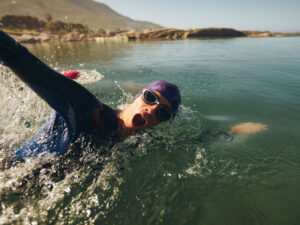 Swimming is a great source of relief from the summer heat and excellent exercise to boot. No matter what your fitness level—or even your mobility level—the gravity-free effects of water can allow you freedom of movement you might not be able to enjoy on land.
Swimming is a great source of relief from the summer heat and excellent exercise to boot. No matter what your fitness level—or even your mobility level—the gravity-free effects of water can allow you freedom of movement you might not be able to enjoy on land.
To go beyond the physical benefits of swimming and tap into the mental health benefits of the great outdoors, consider freeing yourself from the swimming pool. Rivers, bays, oceans, and lakes offer unique challenges for swimmers, leading to increased fitness. And exercising in nature has been shown to improve mood and well-being—it can even help you stick to your exercise plans.
You don’t have to be an Olympic-level swimmer to swim outdoors, but you should be aware of your limitations and seek areas within your comfort zone—e.g., water temperature, surf, lifeguard, marked swim area, easy water access, etc.
Get tips for your office
Be an office hero!
Here are some additional safety tips:
 Where to Swim?
Where to Swim?There are a number of apps and websites that can guide you to local swimming spots. The Waterkeeper Swim Guide’s app helps you find swim spots and even report pollution to local advocacy organizations via your phone. The Wild Swim Map is a user-generated map of swimming areas around the globe. Just input your location or the area you’re traveling to and see what pops up. TripAdvisor can also generate lists, complete with reviews by users if you search for “swimming beaches” or “beaches” and the location. State parks departments may provide lists of beaches and waterways with lifeguards, like this list of lifeguard beaches in California.
Once you know where you’re going, it’s a good idea to get an idea of the water temperature so you know if you might need to bring (or rent) a wetsuit or just pack a thermal swim cap. The website for NOAA’s National Center for Environmental Information shows active readings from local buoys along America’s coastlines. Another website, Surf-forecast.com, provides water temperatures as well as currents, tides, and wave heights. And Seatemperature.org shows current and average temperatures for more than 7,000 locations worldwide. For more experienced swimmers who are looking for specific swim travel destinations, providers such as Water World Swim will help you train for an Alcatraz swim and offer group swims in places like Italy, Greece, Cuba, and the UK. If racing is what you love, this list of global open-water swim races lets you sort by type and provides registration links.
Always ask a local, a lifeguard, or a fellow beachgoer for tips and information when you first arrive at an unknown swimming area. Are there any currents or tides? What is the water temperature? Any hazards such as rip currents, rocky bottoms, animal life, plants, water traffic, or submerged objects you should be aware of?
If you don’t know how to swim, it’s never too late to learn—search online for “swimming lessons near me.” Many adults do not know how to swim—you are not alone. Some local parks and recreation departments offer free or low-cost lessons to new swimmers. The Red Cross provides a list of approved swim lesson providers and also has a free app to encourage swimming progress and water safety. Knowing how to swim saves lives and can give you a lifetime of enjoyable fitness.
Pia Hinckle is publisher at The FruitGuys and an open-water swimmer in the San Francisco Bay.
"*" indicates required fields
Take advantage of faster checkouts and other great benefits.
Create an AccountWe are here to help you provide healthy food, meaning, and a reason to gather in your workplace.
From weekly mixed fruit for break rooms to monthly gifts for remote staff to special projects, we can serve your needs or turn your dreams into a nourishing reality.
Get your weekly dose of the latest fruit info and exclusive updates.
"*" indicates required fields

